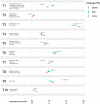Behavioral Change Towards Reduced Intensity Physical Activity Is Disproportionately Prevalent Among Adults With Serious Health Issues or Self-Perception of High Risk During the UK COVID-19 Lockdown
- PMID: 33102424
- PMCID: PMC7554527
- DOI: 10.3389/fpubh.2020.575091
Behavioral Change Towards Reduced Intensity Physical Activity Is Disproportionately Prevalent Among Adults With Serious Health Issues or Self-Perception of High Risk During the UK COVID-19 Lockdown
Abstract
Objectives: We assessed whether lockdown had a disproportionate impact on physical activity behavior in groups who were, or who perceived themselves to be, at heightened risk from COVID-19. Methods: Physical activity intensity (none, mild, moderate, or vigorous) before and during the UK COVID-19 lockdown was self-reported by 9,190 adults between 2020-04-06 and 2020-04-22. Physician-diagnosed health conditions and topic composition of open-ended text on participants' coping strategies were tested for associations with changes in physical activity. Results: Most (63.9%) participants maintained their normal physical activity intensity during lockdown, 25.0% changed toward less intensive activity and 11.1% were doing more. Doing less intensive physical activity was associated with obesity (OR 1.25, 95% CI 1.08-1.42), hypertension (OR 1.25, 1.10-1.40), lung disease (OR 1.23, 1.08-1.38), depression (OR 2.05, 1.89-2.21), and disability (OR 2.13, 1.87-2.39). Being female (OR 1.25, 1.12-1.38), living alone (OR 1.20, 1.05-1.34), or without access to a garden (OR 1.74, 1.56-1.91) were also associated with doing less intensive physical activity, but being in the highest income group (OR 1.73, 1.37-2.09) or having school-age children (OR 1.29, 1.10-1.49) were associated with doing more. Younger adults were more likely to change their PA behavior compared to older adults. Structural topic modeling of narratives on coping strategies revealed associations between changes in physical activity and perceptions of personal or familial risks at work or at home. Conclusions: Policies on maintaining or improving physical activity intensity during lockdowns should consider (1) vulnerable groups of adults including those with chronic diseases or self-perceptions of being at risk and (2) the importance of access to green or open spaces in which to exercise.
Keywords: COVID-19; SARS-CoV2; chronic condition; lockdown; mixed method approach; obesity; perceptions of risk; physical activity (exercise).
Copyright © 2020 Rogers, Waterlow, Brindle, Enria, Eggo, Lees and Roberts.
Figures



References
-
- Lear SA, Hu W, Rangarajan S, Gasevic D, Leong D, Iqbal R, et al. . The effect of physical activity on mortality and cardiovascular disease in 130 000 people from 17 high-income, middle-income, and low-income countries: the PURE study. Lancet. (2017) 390:2643–54. 10.1016/S0140-6736(17)31634-3 - DOI - PubMed
-
- Chekroud SR, Gueorguieva R, Zheutlin AB, Paulus M, Krumholz HM, Krystal JH, et al. . Association between physical exercise and mental health in 1·2 million individuals in the USA between 2011 and 2015: a cross-sectional study. Lancet Psychiatry. (2018) 5:739–46. 10.1016/S2215-0366(18)30227-X - DOI - PubMed
MeSH terms
LinkOut - more resources
Full Text Sources
Medical
Miscellaneous

